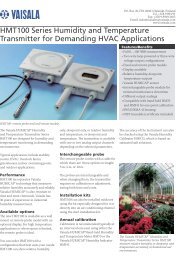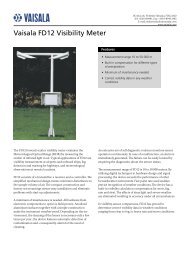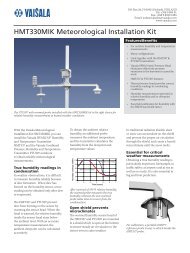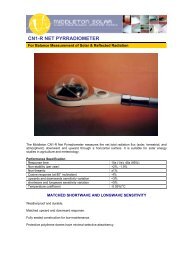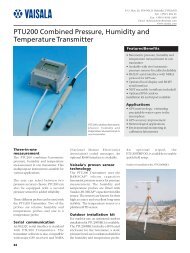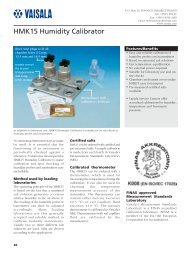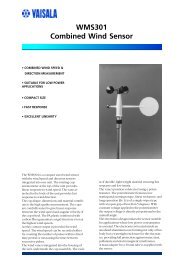MITRAS Brochure in English - Live Data AB
MITRAS Brochure in English - Live Data AB
MITRAS Brochure in English - Live Data AB
You also want an ePaper? Increase the reach of your titles
YUMPU automatically turns print PDFs into web optimized ePapers that Google loves.
One background lum<strong>in</strong>ance meter, mounted<br />
on top of the light transmitter, is sufficient per<br />
runway to measure the background lum<strong>in</strong>ance<br />
value needed <strong>in</strong> visibility calculation.<br />
w<strong>in</strong>dow contam<strong>in</strong>ation exceeds<br />
an acceptable level, a warn<strong>in</strong>g is<br />
sent out and the w<strong>in</strong>dow can be<br />
cleaned. This unique function<br />
extends the clean<strong>in</strong>g <strong>in</strong>tervals<br />
significantly, while the user is<br />
assured of consistently high data<br />
quality.<br />
Each <strong>MITRAS</strong> unit cont<strong>in</strong>uously<br />
monitors several technical parameters<br />
and generates warn<strong>in</strong>g<br />
and alarm messages <strong>in</strong> cases of<br />
fault. The <strong>MITRAS</strong> status can be<br />
monitored remotely over the<br />
modem l<strong>in</strong>e. Automatic monitor<strong>in</strong>g<br />
<strong>in</strong> the transmitter and receiver<br />
covers supply voltages,<br />
<strong>in</strong>ternal temperatures, optical<br />
performance <strong>in</strong>clud<strong>in</strong>g correct<br />
calibration/alignment and detected<br />
failures. This <strong>in</strong>formation can<br />
be <strong>in</strong>terrogated by the service<br />
technician before leav<strong>in</strong>g for the<br />
site. Warn<strong>in</strong>gs of lamp age<strong>in</strong>g<br />
and w<strong>in</strong>dow contam<strong>in</strong>ation are<br />
generated as needed.<br />
The xenon flash lamp’s nom<strong>in</strong>al<br />
lifetime is 8 years at one flash<br />
per second. <strong>MITRAS</strong> extends the<br />
lifetime by adjust<strong>in</strong>g the flash<br />
rate depend<strong>in</strong>g on visibility. An<br />
<strong>in</strong>terval of one second between<br />
flashes is used <strong>in</strong> low visibility.<br />
The flash <strong>in</strong>terval <strong>in</strong>creases stepwise<br />
to 10 seconds when visibility<br />
improves to a measured value<br />
above 10 km.<br />
SUPERIOR ACCURACY<br />
In the WMO <strong>in</strong>tercomparison of<br />
visibility measurements, <strong>MITRAS</strong><br />
achieved the best results concern<strong>in</strong>g<br />
measurement accuracy.<br />
<strong>MITRAS</strong> measures both the transmitted<br />
and the received light<br />
pulse amplitudes. Instead of rely<strong>in</strong>g<br />
on estimates of projected<br />
light power, every transmitted<br />
pulse is measured. Atmospheric<br />
transmittance is then calculated<br />
as the ratio of received and<br />
transmitted light power on a<br />
s<strong>in</strong>gle pulse basis. Receiver electronics<br />
are gated to receive<br />
only light pulses from the transmitter,<br />
and will not accept any<br />
<strong>in</strong>terference light dur<strong>in</strong>g the<br />
<strong>in</strong>terval.<br />
The wide-bandwidth white light<br />
of the transmitter’s xenon flash<br />
lamp and the photopically<br />
corrected receiver sensitivity<br />
provide an ideal match of the<br />
human eye’s spectral range.<br />
<strong>MITRAS</strong> beams are optimized.<br />
Interference from other light<br />
sources, such as the sun or the<br />
aircraft lights is m<strong>in</strong>imized by<br />
accurate beam form<strong>in</strong>g. Light<br />
distribution across the beam is<br />
even. Multiple forward scatter<strong>in</strong>g<br />
and dispersion <strong>in</strong> fog is m<strong>in</strong>imized.<br />
Simplicity of optical design<br />
and good temperature stability<br />
are key factors of the system’s<br />
exceptional stability.<br />
Temperature of the optics is<br />
ma<strong>in</strong>ta<strong>in</strong>ed constant and above<br />
the ambient to prevent condensed<br />
moisture on the optical<br />
surfaces. Control is proportional<br />
to avoid temperature cycl<strong>in</strong>g.



